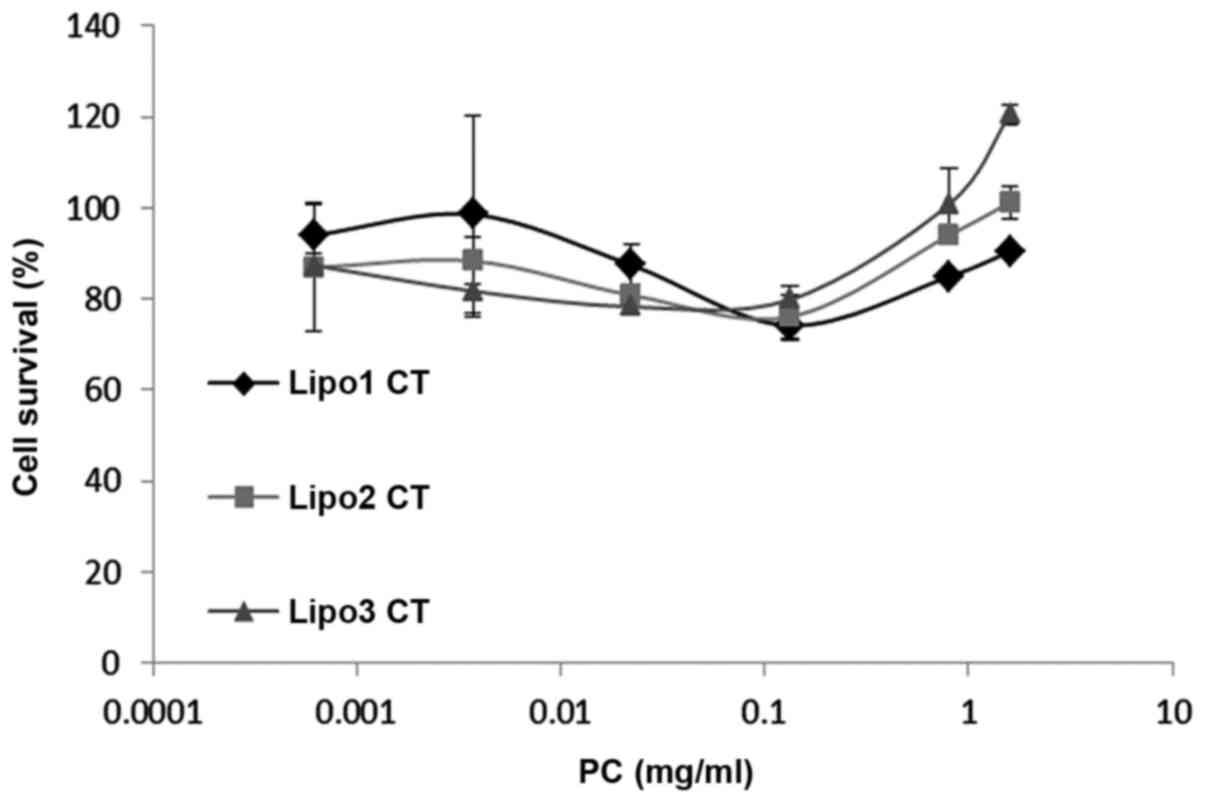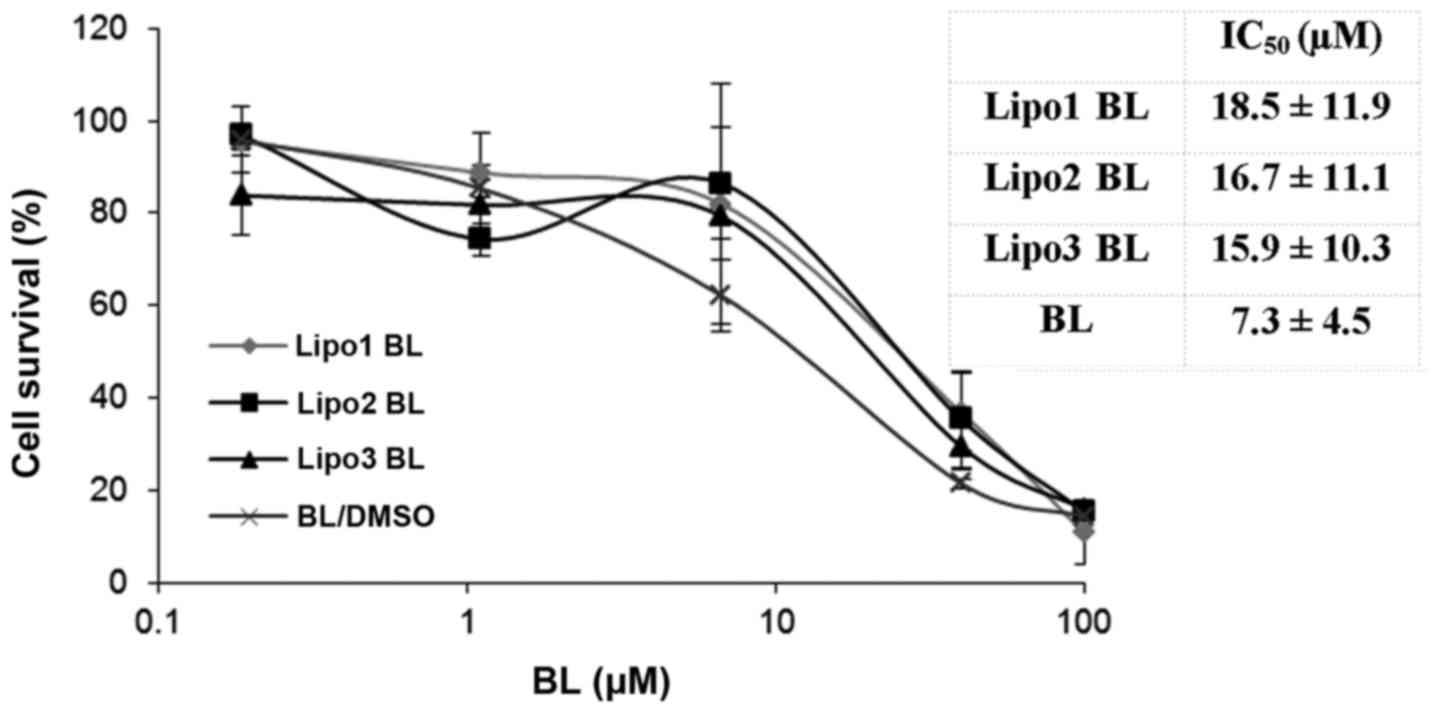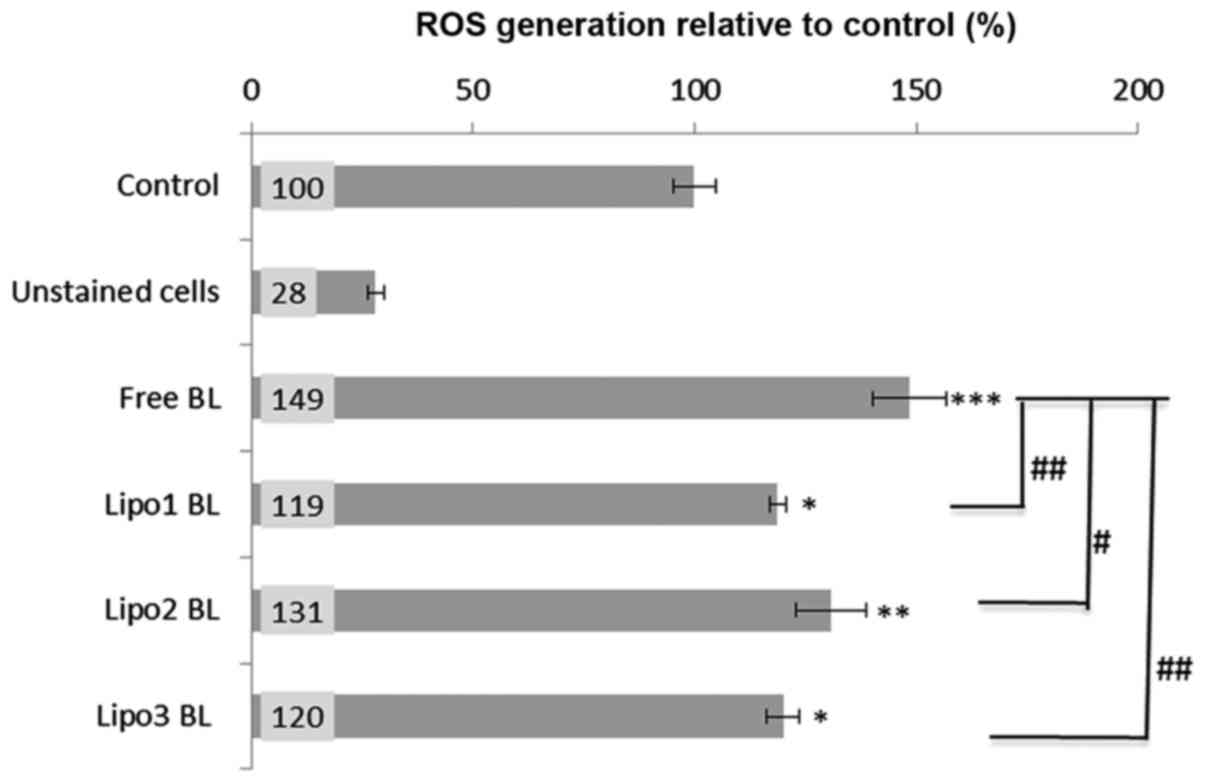|
1
|
Wang Y, Wei S, Wang J, Fang Q and Chai Q:
Phenethyl isothiocyanate inhibits growth of human chronic myeloid
leukemia K562 cells via reactive oxygen species generation and
caspases. Mol Med Rep. 10:543–549. 2014. View Article : Google Scholar : PubMed/NCBI
|
|
2
|
Melo JV and Barnes DJ: Chronic myeloid
leukaemia as a model of disease evolution in human cancer. Nat Rev
Cancer. 7:441–453. 2007. View
Article : Google Scholar : PubMed/NCBI
|
|
3
|
Owen HC, Appiah S, Hasan N, Ghali L,
Elayat G and Bell C: Phytochemical modulation of apoptosis and
autophagy: Strategies to overcome chemoresistance in leukemic stem
cells in the bone marrow microenvironment. Int Rev Neurobiol.
135:249–278. 2017. View Article : Google Scholar : PubMed/NCBI
|
|
4
|
Yan H, Xin S, Wang H, Ma J, Zhang H and
Wei H: Baicalein inhibits MMP-2 expression in human ovarian cancer
cells by suppressing the p38 MAPK-dependent NF-κB signaling
pathway. Anticancer Drugs. 26:649–656. 2015.PubMed/NCBI
|
|
5
|
Guo Z, Hu X, Xing Z, Xing R, Lv R, Cheng
X, Su J, Zhou Z, Xu Z, Nilsson S and Liu Z: Baicalein inhibits
prostate cancer cell growth and metastasis via the
caveolin-1/AKT/mTOR pathway. Mol Cell Biochem. 406:111–119. 2015.
View Article : Google Scholar : PubMed/NCBI
|
|
6
|
Wang N, Ren D, Deng S and Yang X:
Differential effects of baicalein and its sulfated derivatives in
inhibiting proliferation of human breast cancer MCF-7 cells. Chem
Biol Interact. 221:99–108. 2014. View Article : Google Scholar : PubMed/NCBI
|
|
7
|
Peng Y, Guo C, Yang Y, Li F, Zhang Y,
Jiang B and Li Q: Baicalein induces apoptosis of human cervical
cancer HeLa cells in vitro. Mol Med Rep. 11:2129–2134. 2015.
View Article : Google Scholar : PubMed/NCBI
|
|
8
|
Lee HZ, Leung HW, Lai MY and Wu CH:
Baicalein induced cell cycle arrest and apoptosis in human lung
squamous carcinoma CH27 cells. Anticancer Res. 25:959–964.
2005.PubMed/NCBI
|
|
9
|
He X, Pei L, Tong HH and Zheng Y:
Comparison of spray freeze drying and the solvent evaporation
method for preparing solid dispersions of baicalein with Pluronic
F68 to improve dissolution and oral bioavailability. AAPS
PharmSciTech. 12:104–113. 2011. View Article : Google Scholar : PubMed/NCBI
|
|
10
|
Lai MY, Hsiu SL, Tsai SY, Hou YC and Chao
PD: Comparison of metabolic pharmacokinetics of baicalin and
baicalein in rats. J Pharm Pharmacol. 55:205–209. 2003. View Article : Google Scholar : PubMed/NCBI
|
|
11
|
Liang J, Wu W, Liu Q and Chen S:
Long-circulating nanoliposomes (LCNs) sustained delivery of
baicalein (BAI) with desired oral bioavailability in vivo. Drug
Deliv. 20:319–323. 2013. View Article : Google Scholar : PubMed/NCBI
|
|
12
|
de Oliveira MR, Nabavi SF, Habtemariam S,
Erdogan Orhan I, Daglia M and Nabavi SM: The effects of baicalein
and baicalin on mitochondrial function and dynamics: A review.
Pharmacol Res. 100:296–308. 2015. View Article : Google Scholar : PubMed/NCBI
|
|
13
|
Zhang L, Lin G, Chang Q and Zuo Z: Role of
intestinal first-pass metabolism of baicalein in its absorption
process. Pharm Res. 22:1050–1058. 2005. View Article : Google Scholar : PubMed/NCBI
|
|
14
|
Fong YK, Li CR, Wo SK, Wang S, Zhou L,
Zhang L, Lin G and Zuo Z: In vitro and in situ evaluation of
herb-drug interactions during intestinal metabolism and absorption
of baicalein. J Ethnopharmacol. 141:742–753. 2012. View Article : Google Scholar : PubMed/NCBI
|
|
15
|
Seo MJ, Choi HS, Jeon HJ, Woo MS and Lee
BY: Baicalein inhibits lipid accumulation by regulating early
adipogenesis and m-TOR signaling. Food Chem Toxicol. 67:57–64.
2014. View Article : Google Scholar : PubMed/NCBI
|
|
16
|
Tsai TH, Liu SC, Tsai PL, Ho LK, Shum AY
and Chen CF: The effects of the cyclosporin A, a P-glycoprotein
inhibitor, on the pharmacokinetics of baicalein in the rat: A
microdialysis study. Br J Pharmacol. 137:1314–1320. 2002.
View Article : Google Scholar : PubMed/NCBI
|
|
17
|
Tian S, He G, Song J, Wang S, Xin W, Zhang
D and Du G: Pharmacokinetic study of baicalein after oral
administration in monkeys. Fitoterapia. 83:532–540. 2012.
View Article : Google Scholar : PubMed/NCBI
|
|
18
|
Tan ML, Choong PF and Dass CR: Recent
developments in liposomes, microparticles and nanoparticles for
protein and peptide drug delivery. Peptides. 31:184–193. 2010.
View Article : Google Scholar : PubMed/NCBI
|
|
19
|
Huang YB, Tsai MJ, Wu PC, Tsai YH, Wu YH
and Fang JY: Elastic liposomes as carriers for oral delivery and
the brain distribution of (+)-catechin. J Drug Target. 19:709–718.
2011. View Article : Google Scholar : PubMed/NCBI
|
|
20
|
Park SJ, Choi SG, Davaa E and Park JS:
Encapsulation enhancement and stabilization of insulin in cationic
liposomes. Int J Pharm. 415:267–272. 2011. View Article : Google Scholar : PubMed/NCBI
|
|
21
|
Song YK, Hyun SY, Kim HT, Kim CK and Oh
JM: Transdermal delivery of low molecular weight heparin loaded in
flexible liposomes with bioavailability enhancement: Comparison
with ethosomes. J Microencapsul. 28:151–208. 2011. View Article : Google Scholar : PubMed/NCBI
|
|
22
|
Cansell M, Nacka F and Combe N: Marine
lipid-based liposomes increase in vivo FA bioavailability. Lipids.
38:551–559. 2003. View Article : Google Scholar : PubMed/NCBI
|
|
23
|
Guan P, Lu Y, Qi J, Niu M, Lian R, Hu F
and Wu W: Enhanced oral bioavailability of cyclosporine A by
liposomes containing a bile salt. Int J Nanomedicine. 6:965–974.
2011.PubMed/NCBI
|
|
24
|
Isacchi B, Arrigucci S, La Marca G,
Bergonzi MC, Vannucchi MG, Novelli A and Bilia AR: Conventional and
long-circulating liposomes of artemisinin: Preparation,
characterization, and pharmacokinetic profile in mice. J Liposome
Res. 21:237–244. 2011. View Article : Google Scholar : PubMed/NCBI
|
|
25
|
Vural I, Sarisozen C and Olmez SS:
Chitosan coated furosemide liposomes for improved bioavailability.
J Biomed Nanotechnol. 7:426–430. 2011. View Article : Google Scholar : PubMed/NCBI
|
|
26
|
Kim HP, Son KH, Chang HW and Kang SS:
Anti-inflammatory plant flavonoids and cellular action mechanisms.
J Pharmacol Sci. 96:229–245. 2004. View Article : Google Scholar : PubMed/NCBI
|
|
27
|
Lu Y, Joerger R and Wu C: Study of the
chemical composition and antimicrobial activities of ethanolic
extracts from roots of Scutellaria baicalensis Georgi. J Agric Food
Chem. 59:10934–10942. 2011. View Article : Google Scholar : PubMed/NCBI
|
|
28
|
Shieh DE, Liu LT and Lin CC: Antioxidant
and free radical scavenging effects of baicalein, baicalin and
wogonin. Anticancer Res. 20:2861–2865. 2000.PubMed/NCBI
|
|
29
|
Chao JI, Su WC and Liu HF: Baicalein
induces cancer cell death and proliferation retardation by the
inhibition of CDC2 kinase and survivin associated with opposite
role of p38 mitogen-activated protein kinase and AKT. Mol Cancer
Ther. 6:3039–3048. 2007. View Article : Google Scholar : PubMed/NCBI
|
|
30
|
Chen H, Gao Y, Wu J, Chen Y, Chen B, Hu J
and Zhou J: Exploring therapeutic potentials of baicalin and its
aglycone baicalein for hematological malignancies. Cancer Lett.
354:5–11. 2014. View Article : Google Scholar : PubMed/NCBI
|
|
31
|
Cheng YH, Li LA, Lin P, Cheng LC, Hung CH,
Chang NW and Lin C: Baicalein induces G1 arrest in oral cancer
cells by enhancing the degradation of cyclin D1 and activating AhR
to decrease Rb phosphorylation. Toxicol Appl Pharmacol.
263:360–367. 2012. View Article : Google Scholar : PubMed/NCBI
|
|
32
|
Ma GZ, Liu CH, Wei B, Qiao J, Lu T, Wei
HC, Chen HD and He CD: Baicalein inhibits DMBA/TPA-induced skin
tumorigenesis in mice by modulating proliferation, apoptosis, and
inflammation. Inflammation. 36:457–467. 2013. View Article : Google Scholar : PubMed/NCBI
|
|
33
|
Chow JM, Shen SC, Wu CY and Chen YC:
12-o-Tetradecanoylphorbol 13-acetate prevents baicalein-induced
apoptosis via activation of protein kinase C and JNKs in human
leukemia cells. Apoptosis. 11:1999–2011. 2006. View Article : Google Scholar : PubMed/NCBI
|
|
34
|
Lee JH, Li YC, Ip SW, Hsu SC, Chang NW,
Tang NY, Yu CS, Chou ST, Lin SS, Lino CC, et al: The role of
Ca2+ in baicalein-induced apoptosis in human breast
MDA-MB-231 cancer cells through mitochondria- and
caspase-3-dependent pathway. Anticancer Res. 28:1701–1711.
PubMed/NCBI
|
|
35
|
Wang X, Li D, Ghali L, Xia R, Munoz LP,
Garelick H, Bell C and Wen X: Therapeutic potential of delivering
arsenic trioxide into HPV infected cervical cancer cells using
liposomal nanotechnology. Nanoscale Res Lett. 11:942016. View Article : Google Scholar : PubMed/NCBI
|
|
36
|
Wang SX, Michiels J, Ariën KK, New R,
Vanham G and Roitt I: Inhibition of HIV virus by neutralizing Vhh
attached to dual functional liposomes encapsulating dapivirine.
Nanoscale Res Lett. 11:3502016. View Article : Google Scholar : PubMed/NCBI
|
|
37
|
Berger N, Sachse A, Bender J, Schubert R
and Brandl M: Filter extrusion of liposomes using different
devices: Comparison of liposome size, encapsulation efficiency and
process characteristics. Int J Pharm. 223:55–68. 2001. View Article : Google Scholar : PubMed/NCBI
|
|
38
|
Clayton R, Ohagen A, Nicol F, Del Vecchio
AM, Jonckers TH, Goethals O, Van Loock M, Michiels L, Grigsby J, Xu
Z, et al: Sustained and specific in vitro inhibition of HIV-1
replication by a protease inhibitor encapsulated in gp120-targeted
liposomes. Antiviral Res. 84:142–149. 2009. View Article : Google Scholar : PubMed/NCBI
|
|
39
|
Lee JS, Hwang SY and Lee EK: Imaging-based
analysis of liposome internalization to macrophage cells: Effects
of liposome size and surface modification with PEG moiety. Colloids
Surf B Biointerfaces. 136:786–790. 2015. View Article : Google Scholar : PubMed/NCBI
|
|
40
|
Feng J, Iyer A, Seo Y, Broaddus C, Liu B,
VanBrocklin H and He J: Effects of size and targeting ligand on
biodistribution of liposome nanoparticles in tumor mice. Soc Nucl
Med Annu Meet Abstr. 54:13392013.
|
|
41
|
Ye F, Wang H, Zhang L, Zou Y, Han H and
Huang J: Baicalein induces human osteosarcoma cell line MG-63
apoptosis via ROS-induced BNIP3 expression. Tumor Biol.
36:4731–4740. 2015. View Article : Google Scholar
|
|
42
|
Reczek CR and Chandel NS: The two faces of
reactive oxygen species in cancer. Annu Rev Cancer Biol. 1:79–98.
2017. View Article : Google Scholar
|
|
43
|
Galadari S, Rahman A, Pallichankandy S and
Thayyullathil F: Reactive oxygen species and cancer paradox: To
promote or to suppress? Free Radic Biol Med. 104:144–164. 2017.
View Article : Google Scholar : PubMed/NCBI
|
|
44
|
Liou GY and Storz P: Reactive oxygen
species in cancer. Free Radic Res. 44:479–496. 2010. View Article : Google Scholar : PubMed/NCBI
|
|
45
|
Nieborowska-Skorska M, Kopinski PK, Ray R,
Hoser G, Ngaba D, Flis S, Cramer K, Reddy MM, Koptyra M, Penserga
T, et al: Rac2-MRC-cIII-generated ROS cause genomic instability in
chronic myeloid leukemia stem cells and primitive progenitors.
Blood. 119:4253–4263. 2012. View Article : Google Scholar : PubMed/NCBI
|
|
46
|
Simon HU, Haj-Yehia A and Levi-Schaffer F:
Role of reactive oxygen species (ROS) in apoptosis induction.
Apoptosis. 5:415–418. 2000. View Article : Google Scholar : PubMed/NCBI
|
|
47
|
Cadenas E: Mitochondrial free radical
production and cell signaling. Mol Aspects Med. 25:17–26. 2004.
View Article : Google Scholar : PubMed/NCBI
|
|
48
|
Wang J, Yu Y, Hashimoto F, Sakata Y, Fujii
M and Hou DX: Baicalein induces apoptosis through ROS-mediated
mitochondrial dysfunction pathway in HL-60 cells. Int J Mol Med.
14:627–632. 2004.PubMed/NCBI
|
|
49
|
Choi EO, Park C, Hwang HJ, Hong SH, Kim
GY, Cho EJ, Kim WJ and Choi YH: Baicalein induces apoptosis via
ROS-dependent activation of caspases in human bladder cancer 5637
cells. Int J Oncol. 49:1009–1018. 2016. View Article : Google Scholar : PubMed/NCBI
|













